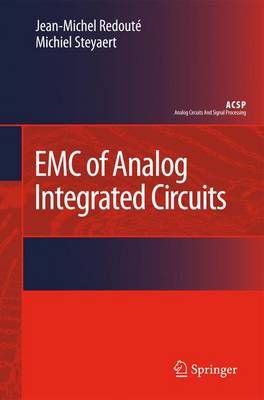- EMC-aware analog integrated circuit design is domain which is continuously gaining in importance
- Paradoxically, literature describing and solving EMC problems in integrated circuits is not widely spread: most EMC-related works describe what should be done outside the integrated circuit (like shielding, etc.). Conversely, this research looks at how EMC incompatibilities can be tackled on-chip
- The structure of the book explains how to identify and solve EMC problems in output stages, input stages and power supply terminals by means of practical design cases
- The design cases described in this work have been validated with measurements and/or simulations
- Last but not least, stressing the first point in this list, the authors strongly believe that EMC problems will keep on increasing in the future
About this book
Environmental electromagnetic pollution has drastically increased over the last decades. The omnipresence of communication systems, various electronic appliances and the use of ever increasing frequencies, all contribute to a noisy electromagnetic environment which acts detrimentally on sensitive electronic equipment. Integrated circuits must be able to operate satisfactorily while cohabiting harmoniously in the same appliance, and not generate intolerable levels of electromagnetic emission, while maintaining a sound immunity to potential electromagnetic disturbances: analog integrated circuits are in particular more easily disturbed than their digital counterparts, since they don't have the benefit of dealing with predefined levels ensuring an innate immunity to disturbances. The objective of the research domain presented in EMC of Analog Integrated Circuits is to improve the electromagnetic immunity of considered analog integrated circuits, so that they start to fail at relevantly higher conduction levels than before.
Table of contents
(7 chapters)
|
|
About the authors
| Jean-Michel Redouté is an accomplished engineer and researcher, originally from Belgium. He obtained his M.S. in Electronics from the Hogeschool Antwerpen in 1998 and an M.Eng. in Electrical Engineering from the University of Brussels in 2001. His professional journey began with Alcatel Bell, where he focused on designing analog microelectronic circuits for telecommunications systems.
In 2009, Redouté joined the Berkeley Wireless Research Center (BWRC) at the University of California, Berkeley, supported by the Belgian American Educational Foundation (BAEF). His work at BWRC concentrated on advanced circuit design, particularly in creating robust analog circuits resistant to electromagnetic interference (EMI). After a year, he transitioned to Monash University in Melbourne as a senior lecturer. In 2018, he became an Associate Professor at the University of Liège, leading research in miniaturized and low-power sensor interfaces, biomedical circuits, energy harvesting, and electromagnetic compatibility. Redouté has also contributed extensively to academic and professional literature, including being an associate editor for the IEEE Sensors Journal. His work is highly relevant in fields like wireless body area networks, integrated imaging systems, and energy-efficient biomedical devices |
Michiel Steyaert is a highly regarded electrical engineer and professor specializing in analog and mixed-signal integrated circuits. He earned his master's degree in electrical-mechanical engineering in 1983 and a Ph.D. in electronics in 1987, both from the Katholieke Universiteit Leuven (KU Leuven), Belgium. Since then, he has been a pivotal figure at the university's Laboratory for Microelectronics and Sensors (ESAT-MICAS), where he became a full professor in 1997. Steyaert's research focuses on high-performance and high-frequency analog circuits for telecommunications, signal processing, and CMOS power management. He has authored or co-authored over 950 academic papers and 31 books. Throughout his career, he has received numerous prestigious awards, including multiple honors from the IEEE and the European Solid-State Circuits Conference. Notably, he is the only European researcher to be recognized for strong contributions to the ISSCC during its 50th, 60th, and 70th anniversaries. Beyond his research, he has held significant administrative roles at KU Leuven, serving as Dean of the Faculty of Engineering Science from 2012 to 2020 and Chair of the Electrical Engineering Department from 2005 to 2012. Steyaert has also supervised 64 Ph.D. graduates, solidifying his influence on the next generation of engineers. His recent honors include the IEEE Donald O. Pederson Solid-State Circuits Award in 2025, reflecting his impactful contributions to microelectronics and circuit design advancements |

